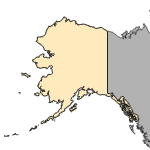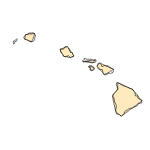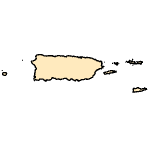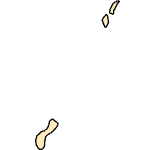Carassius gibelio
(Prussian carp)
Fishes
Exotic |
|
Common name: Prussian carp
Synonyms and Other Names: Gibel carp
Taxonomy: available through
www.itis.gov
Identification: Kottelat and Freyhof (2007) describe Carassius gibelio as being silvery-brown in color with 37-52 gill rakers and 5 ½ branched anal rays; the last simple anal and dorsal rays are strongly serrated; and the peritoneum (lining of the abdominal cavity) is black. This species is morphologically similar to goldfish, Carassius auratus, and common carp, Cyprinus carpio, which could lead to misidentification (Docherty et al. 2017).
Size: Up to 35 cm standard length (SL) (Kottelat and Freyhof 2007)
Native Range: Central-eastern Europe to Siberia (Perdikaris et al. 2012)



|

Alaska |

Hawaii |

Puerto Rico &
Virgin Islands |

Guam Saipan |
Hydrologic Unit Codes (HUCs) Explained
Interactive maps: Point Distribution Maps
Nonindigenous Occurrences:
Ecology: This species inhabits a wide variety of fresh water bodies including ponds, lakes, and slow-running rivers and streams, usually associated with submerged vegetation and/or regular flooding events (Kottelat and Freyhof 2007, Perdikaris et al. 2012). In the northern portion of its native range where temperatures are cooler, spawning occurs at 3-4 years of age, but occurs at 1-2 years in southern Europe from May-July when water temperatures are above 14°C (Kottelat and Freyhof 2007). Spawning occurs in shallow water along warm shorelines on submerged vegetation (Kottelat and Freyhof 2007, Paschos et al. 2004).
This species is a generalist omnivore feeding on plankton, benthic invertebrates, plant material, filamentous algae, and detritus (Kottelat and Freyhof 2007, Özdilek and Jones 2014).
Prussian carp can reproduce sexually or via gynogenesis, in which the female uses the sperm from a related species (i.e., other cyprinids) to activate the development of the egg, however the sperm does not contribute to the genetic composition of the offspring (Kottelat and Freyhoff 2007, Paschos et al. 2004). Gynogenetic populations are most prevalent in newly invaded habitats (Tarkan et al. 2012).
Means of Introduction: The means of original introduction to North America is currently unknown but potentially occurred through contaminated shipments of other aquaculture species or through aquarium or bait fish releases (Elgin et al. 2014). Dispersal has been facilitated by artificial irrigation waterways (Elgin et al. 2014) and likely human mediated transport (Docherty et al. 2017).
Status: This species is established in Alberta and Saskatchewan provinces of Canada (Docherty et al. 2017). An attempt at population control with three-pass electrofishing in tributaries of the Red Deer River in Alberta was not successful, in fact Prussian carp abundances were significantly higher post-removal (Card et al. 2020). Docherty et al. (2017) estimate the spread of Prussian carp to be 233-1250 km2 per year in Alberta.
Impact of Introduction: Prussian carp have the potential to compete for resources with native species. Docherty et al. (2017) found Prussian carp habitat preference overlaps closely with sunfish (Centrarchidae). Their diet preference overlaps with suckers (Catostomidae). Tarkan et al. (2012) found Prussian carp to interfere with spawning of native cyprinids potentially resulting in decreased population size of the latter.
In a mesocosm experiment, the presence of Prussian carp increased total suspended solids in the water column, enhanced the growth of planktonic algae, decreased light conditions, reduced benthic algae growth, reduced zooplankton biomass, and prevented submerged macrophyte development ultimately enhancing eutrophication (Razlutskij et al. 2021).
References: (click for full references)
Card, J.T., J.L.W. Ruppert, C. Donadt, and M.S. Peosch. 2020. A three-pass electrofishing removal strategy is not effective for eradication of Prussian carp in a North American stream network. Journal of Fish and Wildlife Management 11(20):485-493.
Docherty, C., J. Ruppert, T. Rudolfsen, A. Hamann, and M.S. Poesch. 2017. Assessing the spread and potential impact of Prussian Carp Carassius gibelio (Block, 1782) to freshwater fishes in western North America. BioInvasions Records 6(3):291-296.
Elgin, E.L., H.R. Tunna, and L.J. Jackson. 2014. First confirmed records of Prussian carp, Carassius gibelio (Block, 1782) in open waters of North America. BioInvasions Records 3(4):275-282.
Kottelat, M., and J. Freyhof. 2007. Handbook of European freshwater fishes. Kottelat, Cornol, Switzerland and Freyhof, Berlin, Germany.
Lovas-Kiss, Á., O. Vincze, V. Löki, F. Pallér-Kapusi, B. Halasi-Kovács, G. Kovács, A.J. Green, and B.A. Luckács. 2020. Experimental evidence of dispersal of invasive cyprinid eggs inside migratory waterfowl. PNAS 117(27):15397-15399.
Özdilek, S.Y., and R.I. Jones. 2014. The diet composition and trophic position of introduced Prussian carp Carassius gibelio (Bloch, 1782) and native fish species in a Turkish river. Turkish Journal of Fisheries and Aquatic Sciences 14:771-776.
Paschos, I., C. Nathanailides, M. Tsoumani, C. Perdikaris, E. Gouva, and I. Leonardos. 2004. Intra and inter-specific mating options for gynogenetic reproduction of Carassius gibelio (Block, 1782) in Lake Pamvotis (NW Greece). Belgian Journal of Zoology 134(1):55-60.
Perdikaris, C., A. Ergolavou, E. Gouva, C. Nathanailides, A. Chantzaropoulos, and I. Paschos. 2012. Carassius gibelio in Greece: The dominant naturalised invader of freshwaters. Reviews in Fish Biology and Fisheries 22:17-27.
Razlutskij, V., X. Mei, N. Maisak, E. Sysova, D. Lukashanets, A. Makaranka, E. Jeppesen, and X. Zhang. 2021. Omnivorous carp (Carassius gibelio) increase eutrophication in part by preventing development of large-bodied zooplankton and submerged macrophytes. Water 13:1497.
Tarkan, A.S., Ö. Gaygusuz, Ç. Gürsoy Gaygusuz, G. Saç, and G.H. Copp. 2012. Circumstantial evidence of gibel carp, Carassius gibelio, reproductive competition exerted on native fish species in a mesotrophic reservoir. Fisheries Ecology and Management 19:167-177.
Author:
Brown, M.E.
Revision Date: 8/1/2022
Citation Information:
Brown, M.E., 2026, Carassius gibelio (Bloch, 1782): U.S. Geological Survey, Nonindigenous Aquatic Species Database, Gainesville, FL, https://nas.er.usgs.gov/queries/FactSheet.aspx?SpeciesID=2924, Revision Date: 8/1/2022, Access Date: 1/16/2026
This information is preliminary or provisional and is subject to revision. It is being provided to meet the need for timely best science. The information has not received final approval by the U.S. Geological Survey (USGS) and is provided on the condition that neither the USGS nor the U.S. Government shall be held liable for any damages resulting from the authorized or unauthorized use of the information.